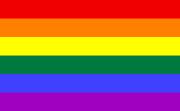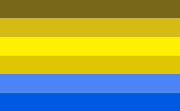Photography Essay: Color Blindness and the Way One Sees the World
November 14, 2007
Do you see a yellow square and a red circle? If not, you’re color deficient.
As with all art, tastes and styles in photography vary dramatically. However, in addition to interpreting a photograph (and it’s inherent meaning), we all see the image in a different way. I don’t mean see in the esoteric way meaning understand or comprehend, but literally in the sense that the color you think is red may actually be green.
Just as all snowflakes are supposedly different, I truly believe that nobody sees the world in exactly the same way. If this truly is so, how do we as photographers communicate our vision to our viewers while knowing that they will not be able to see exactly what we want them to see? The answer to this question may reveal more about the photographer than it may at first suggest.
My photography has to please me, before I can even think about the reaction of the viewer. Photography is an intensely personal passion for me, and the process of creating the image up to the point of pressing the shutter is a very rewarding experience. Thus to me, the process of creation is fulfilling in and of itself, even before thinking about the reaction of someone else.
After the image is captured, all I can do is create a final product that I am satisfied with and that I think some one else would like as well. Whether or not they see what I see is much less relevant than making sure they have a reaction to the photograph at all. By taking thousands of photographs, looking at other photographers, and soliciting opinion on my work, I begin to build an understanding of what people like and begin to integrate that into my style while at the same time, maintaining my own preferred style.
Foggy Fall Foliage, New Hampshire
This summer, I was lucky enough to take a class at the Maine Media Workshops with Stephen Johnson who was a big fan of simple composition with muted real world colors instead of the jump-off-the-page Velvia over-saturated color photography that is all too common these days with digital cameras. His views, although not always shared, encouraged me to think about what I was really trying to convey with my photography and how I was going to go about doing it. Although I still really enjoy vibrant colors in some photographs, I’m increasingly fascinated by subtlety in photography. One thing I enjoy immensely about digital photography, is my ability to enhance subtlety. By that I mean, I’m able to create a focus on an area of an image that may otherwise have been overlooked such as the incredible amount of texture in seemingly grey monolithic skies.
All of this brings me back around to how people see color. This got me thinking about color blindness and I wondered whether there are many color blind photographers out there. When I read in numerous sources that color blindness affected 1 in 200 women and 1 in 12 men, I realized that this is most likely a significant number of photographers.
In my research I was lucky enough to discover The Colorblind Photographer which is a nice photography blog by a color blind photographer. (Check out his beautiful gallery here.) In addition to his interesting photos he discusses what it is like to be a color blind, or more correctly, color deficient photographer. Wikipedia has a lot of very interesting information on color blindness here. Basically there are three types of inherited color blindness:
1. Monochromancy – Two or all three cone pigments are missing. Basically this person can only see in black and white.
2. Dichromancy – One of the three color mechanisms are not functioning. This is fairly severe and usually occurs to men. This person sees colors that are much less varied and off in hue. Color is reduced to two dimensions.
3. Anomalous Trichromacy – One of the three cone pigments is functional, but altered. This means that the colors that the person sees are just different and color vision is impaired.
Below are two flags. The one on the left looks they way a person with normal color vision would see it. On the right is the way someone with at type of dichromatic color deficiency would see it. Clearly this change in palette provides a major challenge in sharing one’s photographic vision. But does it also open up new creative opportunities?
Flag seen by normal color vision (left), flag seen by person with a type of dichromatic color deficiency (right)
In addition to the previously mentioned website, there is an interesting post here on color blindness by a color blind web designer in Egypt. Check out his website, as it seems his color blindness has not hindered his proficiency at design. There is also a Flickr group for color blind photographers.
Do you know or are you color blind? Do you take photographs? If not, do you think that you see colors differently from me anyway? I’d love to hear your comments and I hope this will be an ongoing conversation.




November 14, 2007 at 2:50 am
eli,
i’m not colorblind (i don’t think) but i share your opinion that no two people see the world the same way. we can never be sure…
this is a beautiful article on cameras that i think you’d enjoy, if you haven’t read it already
http://www.newyorker.com/reporting/2007/09/24/070924fa_fact_lane
jacki
November 15, 2007 at 6:02 pm
for many years when I was quite young(pre teen et al) I was very aware of a difference in my perceprtion of red between my right ewye and my left. it actually seems to have evened out but that early observation led me to a lot of philosophical speculation about much larger issues. carl burak
July 21, 2009 at 2:14 pm
Dear everyone who is reading– I see the square but no tthe circle. oh well. Bbbye. Love ya’ll.
July 21, 2009 at 2:17 pm
I agree on all of this, and i am sorry for the people that are color blind like this! They can’t see the beautiful color of life.
Tiffany Ortonougesa
January 30, 2010 at 7:34 am
…or are WE all color blind to the way THEY see it?
January 30, 2010 at 8:15 am
Your essay is very interesting and I am fascinated by the way the camera lens views things versus our own eye. I agree that photography should be about making something that is interesting to you, sharing it, and then getting feedback from others the way they see it. Color blindness and photography never quite crossed my mind in the same thought until a day ago when I was walking with a friend around sunset and I noticed the “golden” light being cast on different subjects. I don’t know if it would’ve affected me as much if I wasn’t currently taking a Color Photography class. I was excited to see it. The red brick of one building almost glowing in a rich crimson red from the sun setting on the horizon. I took a few pictures and told my friend to look at how “red” that building was (see “Golden” post in my blog for pictures). He couldn’t see it that way though. That is when it really hit me that not everyone understands or sees the world the same. I wish I could grasp what he sees but then I suppose it helps keeps things interesting and fresh. So, I want to wrap up my comment with a question in response to your essay, is Form and/or content essential to what drives your photography and helps everyone get a similar but different meaning?
January 30, 2010 at 10:16 am
[…] just the way we understand and pull meaning from but in how the photograph is actually seen. One photo essay in particular was like my front door into understanding such a difference. I was amazed to see such […]